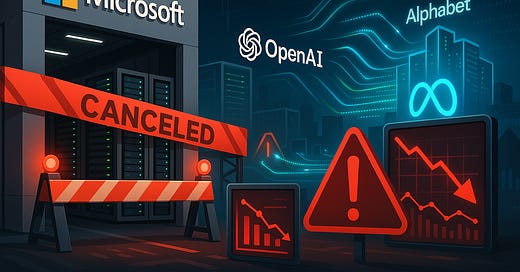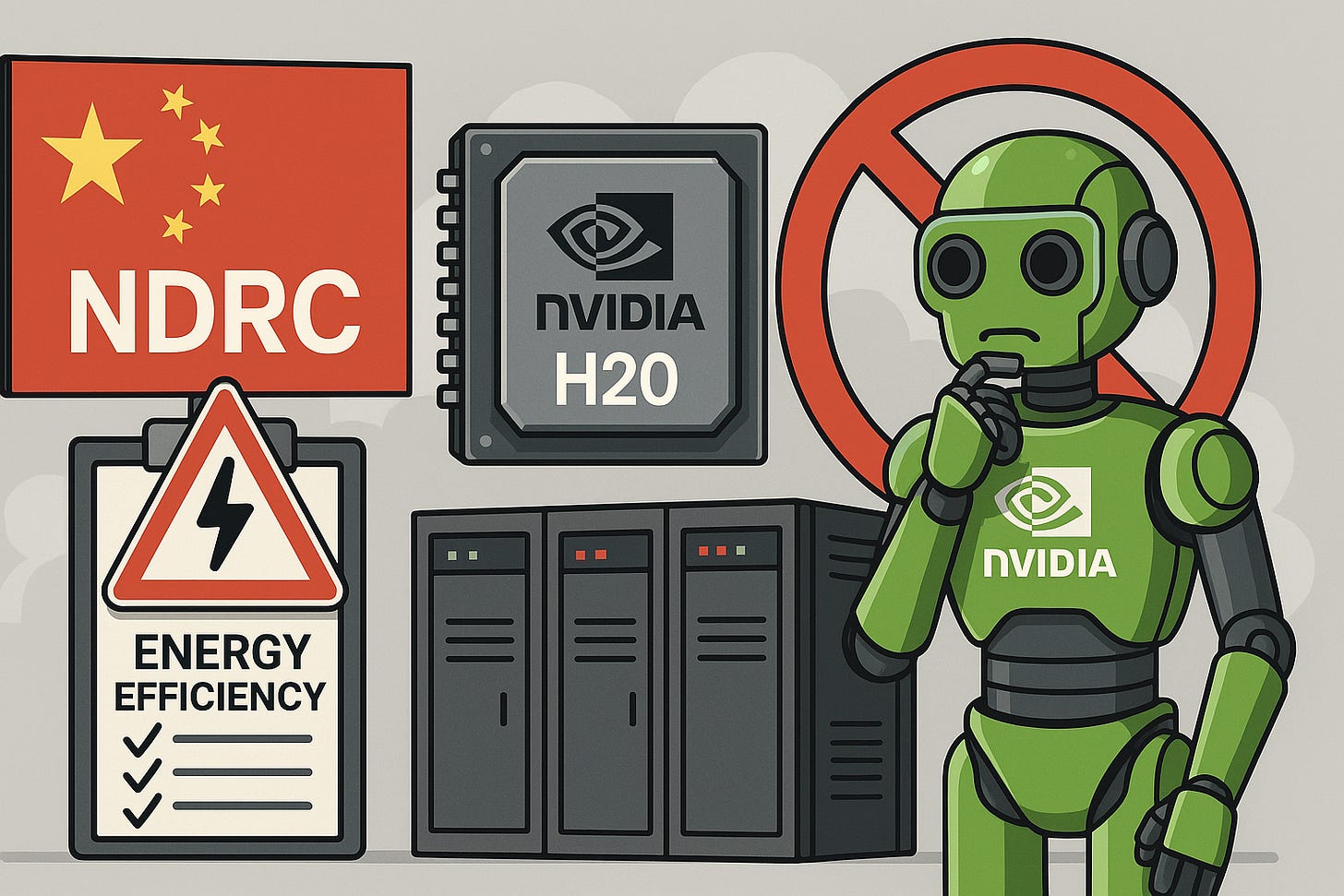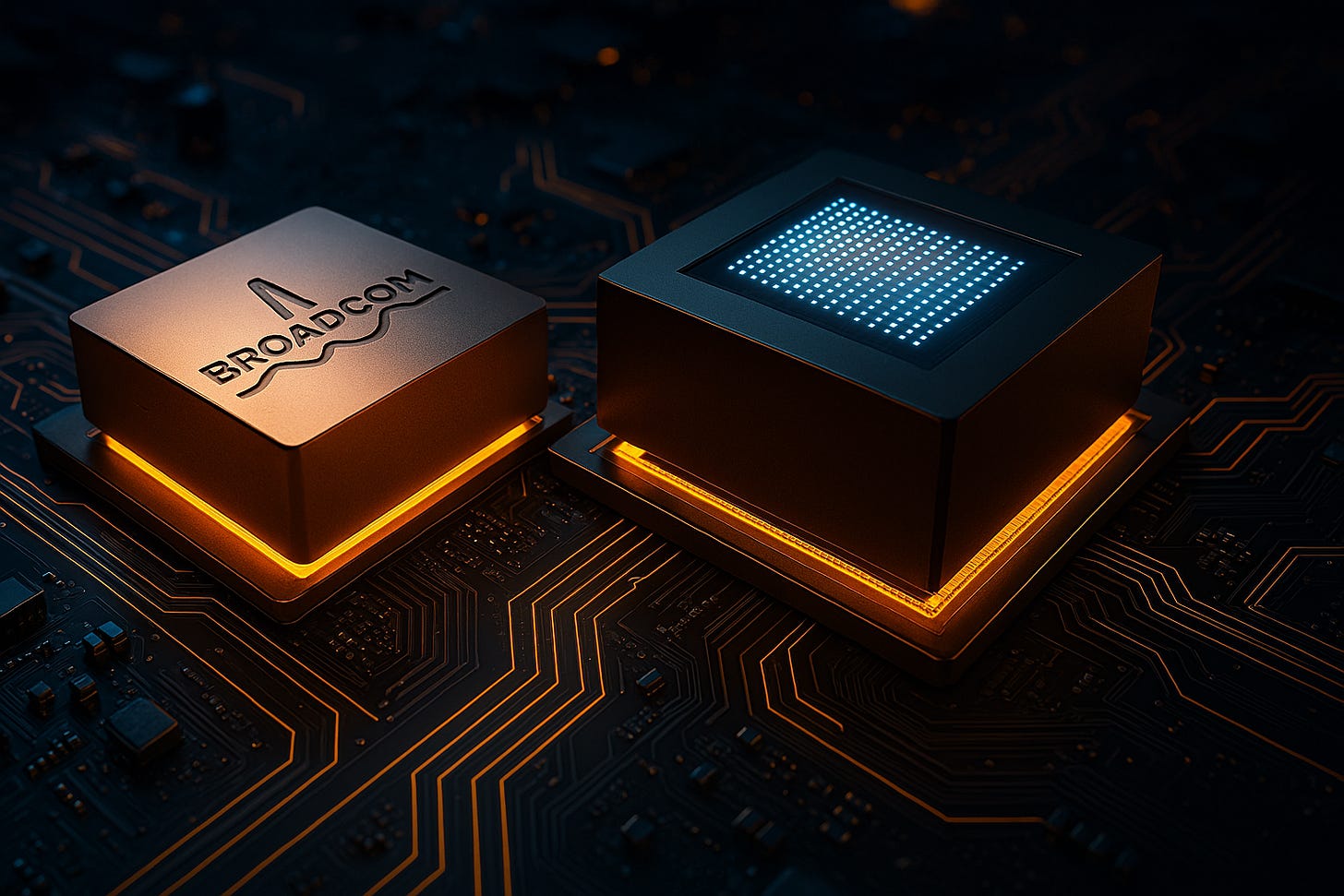Welcome, AI & Semiconductor Investors,
Nvidia faces a potential $17B dilemma as China’s new data center efficiency rules threaten to undermine its custom H20 AI chip in one of its biggest markets.
We’ll also uncover Broadcom’s power-slashing DSP breakthroughs fueling next-gen AI clusters, and dive into Microsoft’s surprising decision to scrap massive data center projects — Let’s Chip In
What The Chip Happened?
🤯 Nvidia Caught in China’s Energy Efficiency Crossfire
🚀 Broadcom Powers AI Connections with New 3nm DSP PHYs
⚠️ Microsoft Cancels Big Data Center Plans
[Monolithic Power Systems Poised for Next-Level Growth in AI and Automotive]
Read time: 7 minutes
NVIDIA (NASDAQ: NVDA)
🤯 Nvidia Caught in China’s Energy Efficiency Crossfire
What The Chip: China’s National Development and Reform Commission (NDRC) introduced stricter data center energy rules in early 2025, challenging Nvidia’s compliance in one of its largest markets. Nvidia’s H20 chip, specifically tailored for China due to U.S. export controls, may not meet these new standards.
Details:
⚡ Tight New Rules: China’s NDRC is pushing data centers to use more efficient chips and renewable power, part of China’s broader plan to peak carbon by 2030 and achieve carbon neutrality by 2060.
♻️ Renewables Rising: Solar and wind energy capacity in China surpassed coal for the first time in early 2025, but coal still remains a large portion of China’s electricity mix.
❌ Nvidia’s H20 Chip at Risk: Nvidia designed the H20 specifically for the Chinese market under U.S. export restrictions, but it may not meet these new efficiency standards—potentially imperiling its $17 billion annual business in China.
🔍 Regulatory Scrutiny: Chinese regulators are watching Nvidia’s compliance on both antitrust and energy rules, intensifying pressure on the company in a strategically important market.
✅ Energy-Efficient Innovations: Nvidia highlights advanced cooling systems and AI-driven power optimizations. “We remain committed to delivering next-gen computing solutions that align with global sustainability goals,” said Jensen Huang, CEO of Nvidia.
⚠️ Geopolitical Tensions: Ongoing tech restrictions and heightened U.S.-China competition could further complicate Nvidia’s prospects in the region.
Why AI/Semiconductor Investors Should Care: These developments showcase how global tech leaders must adapt to evolving sustainability demands, especially in major markets like China. For investors, it underscores the importance of monitoring regulatory changes and the potential impact on both short-term sales and long-term growth trajectories.
Moore Semiconductor Investing
📗 [NEW!!] Unlock Q4 Semiconductor Earnings --- 60% OFF (NEW EARNINGS)
What The Chip: Get a front-row seat to the financials shaping the semiconductor industry. This continuously updated e-book by Jose Najarro distills the latest Q4 quarterly insights—from wafer production trends to AI chip breakthroughs—into a single comprehensive resource.
Details:
🔵 Dynamic Updates: Start with giants like TSMC and ASML, then expand to 30+ companies as their Q4 2024 earnings roll in. Earnings are restarting!!
🔵 Broad Coverage: From traditional chipmakers to cutting-edge AI semiconductor players, get the full picture as it emerges.
Why AI/Semiconductor Investors Should Care: This evolving earnings handbook gives you a strategic edge. Understanding quarterly earnings data is crucial for gauging industry health, discovering new growth leaders, and aligning your investment approach with emerging technological waves.
Disclaimer: For educational and informational purposes only. Not financial advice. Consult with a qualified professional before making any investment decisions. Updates are only for the Quarter of Earnings.
Broadcom (NASDAQ: AVGO)
🚀 Broadcom Powers AI Connections with New 3nm DSP PHYs
What The Chip: On March 25, 2025, Broadcom unveiled two cutting-edge 200G/lane DSP PHYs—Sian3 and Sian2M—aimed squarely at next-generation AI clusters. This launch tackles the biggest roadblock in AI networking today: reducing power consumption for 800G and 1.6T optical interconnects.
Details:
⚡ Lowest Power at 3nm: Sian3 uses a 3nm process that slashes power consumption by over 20% for 1.6T modules, setting new efficiency benchmarks in AI environments.
🤖 Short-Reach Champ: Sian2M integrates VCSEL drivers, optimizing power and cost for 800G and 1.6T short-reach MMF links in AI clusters. “Our new 3nm Sian3 delivers over 20% power reduction,” noted Vijay Janapaty, Broadcom’s VP and GM of Physical Layer Products Division.
🔧 Proven VCSEL Tech: Broadcom’s 200G VCSEL technology has already logged more than 5 trillion field device hours, reflecting a <1 FIT (Failure in Time) rate and underlining reliability.
📈 Growing TAM: LightCounting analyst-at-large Bob Wheeler states, “By 2028, we expect 1.6T optical transceivers will consume more than $1 billion worth of PAM4 DSPs,” emphasizing the expanding market for high-speed connectivity.
🔗 System Scalability: With integrated laser drivers and advanced DSP features, module makers can rapidly design 200G optics, improving the density and scalability needed for AI-driven data centers.
⏱️ Availability: Early samples are shipping now, with volume production of Sian3 expected in Q3 2025. Richard Huang, CEO of Eoptolink Technology, said, “These innovations enable scalable, high-density optical connectivity that meets the evolving demands of next-generation AI infrastructure.”
Why AI/Semiconductor Investors Should Care: These new DSP PHYs directly address the soaring bandwidth demands of AI/ML clusters—while sharply reducing power draw. As AI compute and storage infrastructures balloon in size, solutions that efficiently scale interconnect bandwidth can unlock both cost and performance advantages, positioning Broadcom and its ecosystem partners for growth in the high-speed optical market.
Microsoft (NASDAQ: MSFT)
⚠️ Microsoft Cancels Big Data Center Plans
What The Chip: On Wednesday, March 26, 2025, an analyst note from TD Cowen revealed that Microsoft has scrapped two major data center projects in the U.S. and Europe, each with over 2 gigawatts of capacity. This move contributed to a broader tech sell-off as investors reevaluated the implications for cloud growth and AI demand.
Details:
🚧 Cancellations & Delays: According to TD Cowen analyst Michael Elias, Microsoft walked away from two data centers and delayed or canceled leases in recent months.
💡 OpenAI Workloads Under Review: Elias said Microsoft’s pullback “was largely driven by the decision to not support incremental Open AI training workloads.”
📉 Market Reaction: Microsoft dropped 1.3% on Wednesday, while the Nasdaq Composite slid 2%. Nvidia fell 6%, extending its monthly decline, and data center infrastructure provider Vertiv plunged 11%.
🔄 Google & Meta Step In: The note highlighted that Alphabet (Google’s parent) and Meta Platforms are offsetting some of Microsoft’s canceled lease capacity, particularly in global and U.S. markets, respectively.
🏭 Oversupply Concerns: Elias added, “We continue to believe the lease cancellations and deferrals of capacity points to data center oversupply relative to its current demand forecast.”
🎮 Strategic Shift: Microsoft, known for Windows and Xbox, appears to be refocusing its data center footprint in light of shifting cloud and AI training priorities.
Why AI/Semiconductor Investors Should Care: Data center capacity is at the heart of AI training and cloud growth. A slowdown from Microsoft could signal short-term demand constraints, but the gap is quickly being filled by other hyperscalers like Alphabet and Meta. Investors should watch for shifts in data center investment among major players, as these moves could influence chip demand, equipment spending, and overall market sentiment.
Youtube Channel - Jose Najarro Stocks
[NEW] Semiconductor Q4 Earnings Book — 60% OFF
X Account - @_Josenajarro
Disclaimer: This article is intended for educational and informational purposes only and should not be construed as investment advice. Always conduct your own research and consult with a qualified financial advisor before making any investment decisions.
The overview above provides key insights every investor should know, but subscribing to the premium tier unlocks deeper analysis to support your Semiconductor, AI, and Software journey. Behind the paywall, you’ll gain access to in-depth breakdowns of earnings reports, keynotes, and investor conferences across semiconductor, AI, and software companies. With multiple deep dives published weekly, it’s the ultimate resource for staying ahead in the market. Support the newsletter and elevate your investing expertise—subscribe today!
[Paid Subscribers] Monolithic Power Systems Poised for Next-Level Growth in AI and Automotive
Executive Summary
*Reminder: We do not talk about valuations, just an analysis of the earnings/conferences
Monolithic Power Systems, Inc. (MPS) recently held its 2025 Analyst and Investor Day on March 20, spotlighting its robust expansion across multiple end markets. Management shared highlights of MPS’s extraordinary run of annual revenue growth—averaging 24.9% from 2018 to 2024—and discussed its latest product innovations in power semiconductors, automotive solutions, data center infrastructure, and battery management. As MPS Chief Executive Officer, Michael Hsing, succinctly put it, “MPS doesn’t make anything; we use our knowledge to make money. We design a lot of products, have a lot of fun, and our customers do as well.”
From delivering power management solutions for advanced data center accelerators to supporting highly integrated, safe, and scalable automotive electronics, MPS’s portfolio rests on a foundation of technical leadership. Chief Financial Officer, Bernie Blegen, noted that despite broader market swings, MPS has maintained its long-term target of outgrowing the market by 10% to 15% annually. A new corporate model underscores this commitment: stable gross margins in the 55% to 60% range, continued investment in R&D to fuel diversified product roadmaps, and returning up to 50% of free cash flow to shareholders.
With products in 30,000 customer applications worldwide, MPS emphasizes cross-pollinating its technology from one market to another—such as taking data center power architectures into automotive electrification. This strategy has already resulted in growing momentum for its integrated power modules, battery management solutions, and high-voltage power converters. At the 2025 Investor Day, MPS executives demonstrated how this approach positions the company to tackle rising power demands in AI accelerators, industrial automation, and electric vehicles.
Growth Opportunities
Expanding AI and Data Center Power Solutions
A central theme at the Investor Day was MPS’s success in powering next-generation data center hardware, especially artificial intelligence (AI) accelerators. Executive Vice President, Computing Power, Jinghai Zhou, explained MPS’s so-called “Jinghai’s Law” for GPUs (graphics processing units) and other specialized processors: “Every two to three years, the processor’s power consumption doubles, but the board space for power conversion is cut in half.” This environment demands smaller, more efficient, and higher-density power modules—an area where MPS excels due to its monolithic integration approach. Zhou underscored that “monolithic is the best way to do power integration to improve density,” leading MPS to design modules capable of delivering multi-kilowatt output in ever tighter footprints.







